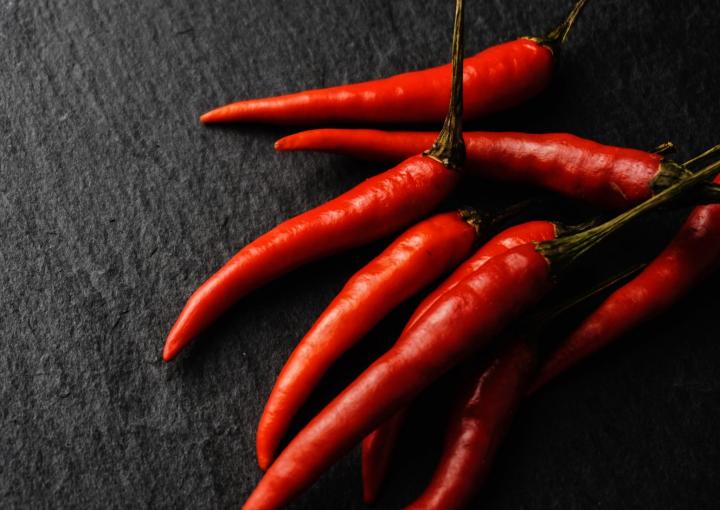Not only are hot peppers delicious in cooking, but also they have healing powers—triggering a natural high and providing pain relief. Learn more about hot peppers for health and happiness!
Last summer, we harvested a bumper crop of Anaheim-type chile peppers, many of which I roasted, peeled, and froze. Mmm-mmm! Nothing provides winter comfort and joy better than a bowl of spicy chili or an aromatic pepper-laced vegetable soup simmered on the woodstove.
Humans have been growing and eating hot peppers for at least 7,000 years, and, for at least as long, indigenous healers have been prescribing them in some form for pretty much everything that ails us, inside and out.
Modern research has borne out some of these health-promoting uses (and found conflicting evidence for others). Researchers continue to explore the use of hot peppers or their constituents for preventing or treating various cancers, weight loss, diabetes prevention and management, cluster headaches, skin disorders, respiratory diseases (including colds, coughs, and flu), digestive ailments, and many other health problems.
How Hot Peppers Heal
Although medical researchers say that the healing virtues of peppers result from numerous constituent compounds and their interaction, the phytocompounds called capsaicinoids (the most common of which is capasaicin) produce the sensation of heat that you feel when you eat a hot pepper or unfortunately happen to rub your eyes after handling one.
Plant scientists theorize that pepper plants manufacture capsaicinoids to deter mammal pests (whose molars can grind and destroy the seeds). This allows whole seeds to be dispersed by birds, whose tissues aren’t irritated by capsaicin.
Over the centuries, plant breeders have developed multitudes of hot pepper varieties, with widely varying degrees of “heat.” However, a pepper’s hotness depends not only on its genetic makeup, but also on the soil that produced it, the weather during its growing season, how the crop was grown, when it was harvested, how it was stored, and how it is used.
The most common measure of the heat of hot peppers is the Scoville Scale (after Wilbur Scoville, the American pharmacist who invented it). The mild, Anaheim-type peppers that I grow register between 1,000 and 2,500 Scoville units; habaneros measure between 100,000 and 350,000; and the pepper spray used by law enforcement comes in at somewhere around 2 million units.
Natural High, Natural Cooling
Many people love intensely hot food for the euphoria that it produces after the burn abates. Scientists theorize that the burning pain produced by the capsacinoids triggers the release of endorphins, the body’s natural painkillers.
Counterintuitively, hot peppers also cause a natural cooling effect in hot weather by increasing sweating, one reason that anthropologists suggest that the closer native cuisines are to the Equator, the more they incorporate hot ingredients.
Peppers for Pain Relief
Although the hotness of a hot pepper doesn’t actually damage skin or mucous membranes, one way that it may promote healing is by tricking the body into believing that it’s been injured, thus triggering various natural immune and painkilling responses.
You’ve no doubt seen many over-the-counter products that claim to relieve the pain of arthritis, muscle pulls and aches, sprains, and shingles. The most effective of these products contain capsaicin.
The use of hot peppers for pain relief also seems counterintuitive, but science confirms that it works.
Using these capsaicin-containing products generally offers relief only after several applications. The first few applications are likely to sting, but gradually the pain gives way to relief. Scientists theorize that the capsaicin works by gradually depleting something called substance P (or “SP”), a neurotransmitter that sends pain signals to the brain.
The temporary inflammation and redness will subside as the capsaicin depletes substance P, and your body should experience less pain in the region.
Always confer with your healthcare professional before using capsaicin or hot peppers for any therapeutic purpose.

Image credit: Liliia Kyrylenko/Getty Images
Make your own capsaicin oil or cream
It’s inexpensive and easy to make your own pain-relieving cream.
Combine 2 tablespoons of powdered hot chile peppers (I use cayenne) with 2 cups of olive or canola oil. Heat on low temperature in a dedicated stainless saucepan, stirring occasionally. Let this sit for a few days and then rewarm the mixture and strain it through cheesecloth into a big glass jar (with a lid). If you want to create a thicker product similar to a cream, add an ounce or two of grated beeswax or beeswax beads to the warm mixture and stir to dissolve. Cover and store in a cool place.
To use, rub the oil or cream into the sore or chronically inflamed area several times a day. Wear kitchen gloves or (for smaller areas) use a cotton swab.
Cautions on the use of your homemade capsaicin product!
- Do not apply this to broken skin or burned areas.
- Do not apply immediately after a hot bath or shower.
- Do not use with a heating pad.
- Do not use on young children.
Cautions
Although the “heat” of hot peppers isn’t damaging, therapeutic use of hot peppers does carry a number of cautions. Capsaicin may interact with a number of prescription and over-the-counter products. Check this list carefully before you use it externally or internally.
Growing Peppers
To learn more about growing peppers and pepper problems, visit the Almanac’s Pepper Growing Guide.
There is also a helpful “how to” video that demonstrates how to grow peppers here.
Growing your own hot peppers? Learn how to deal with hot pepper problems in the garden.










